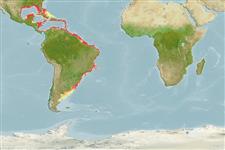Environment: milieu / climate zone / depth range / distribution range
Ecologia
marinhas; Água doce; estuarina demersal; catádromo (Ref. 46888); intervalo de profundidade 10 - ? m (Ref. 3791). Subtropical; 32°N - 51°S
Western Atlantic: Bermuda, Florida (USA), Bahamas, and throughout the Caribbean Sea to Argentina.
Length at first maturity / Tamanho / Peso / Idade
Maturity: Lm 35.0, range 40 - ? cm
Max length : 80.0 cm TL macho/indeterminado; (Ref. 5217); 69.0 cm TL (female); common length : 40.0 cm TL macho/indeterminado; (Ref. 5217); peso máx. Publicado: 9.0 kg (Ref. 5217)
Espinhos dorsais (total) : 5; Raios dorsais moles (total) : 8; Espinhos anais: 3; Raios anais moles: 8.
Inhabit coastal marine waters and brackish estuaries (Ref. 3791); also found in hyper-saline lagoons and may enter freshwater (Ref. 5217). Never far from the sea (Ref. 3791). Form sizeable schools (Ref. 3791). Appear to undergo trophic migrations along the coasts (Ref. 35237). Feed on organic detritus and filamentous algae (Ref. 9626). Oviparous, eggs are pelagic and non-adhesive (Ref. 205). Spawn several million eggs (Ref. 35237) at sea (Ref. 3791). Also caught with beach nets (Ref. 5217). Marketed fresh and salted (Ref. 5217). The roe is marketed salt-pickled and dried and considered a delicacy (Ref. 5217).
Life cycle and mating behavior
Maturities | Reprodução | Spawnings | Egg(s) | Fecundities | Larvas
Robins, C.R. and G.C. Ray, 1986. A field guide to Atlantic coast fishes of North America. Houghton Mifflin Company, Boston, U.S.A. 354 p. (Ref. 7251)
Categoria na Lista Vermelha da IUCN (Ref. 130435)
Ameaça para o homem
Harmless
Utilização humana
Pescarias: espécies comerciais; Aquacultura: espécies comerciais
Ferramentas
Relatórios especiais
Descarregue XML
Fontes da internet
Estimates based on models
Preferred temperature (Ref.
123201): 22.5 - 27.7, mean 25.5 °C (based on 280 cells).
Phylogenetic diversity index (Ref.
82804): PD
50 = 0.5000 [Uniqueness, from 0.5 = low to 2.0 = high].
Bayesian length-weight: a=0.01047 (0.00905 - 0.01211), b=2.95 (2.92 - 2.98), in cm total length, based on LWR estimates for this species (Ref.
93245).
Nível Trófico (Ref.
69278): 2.0 ±0.00 se; based on food items.
Resiliência (Ref.
120179): Médio, tempo mínimo de duplicação da população 1,4 - 4,4 anos (K=0.11-0.24; assuming tm=2-3).
Prior r = 0.33, 95% CL = 0.22 - 0.50, Based on 7 data-limited stock assessments.
Fishing Vulnerability (Ref.
59153): Moderate vulnerability (37 of 100).
Climate Vulnerability (Ref.
125649): High vulnerability (57 of 100).
Nutrients (Ref.
124155): Calcium = 152 [57, 453] mg/100g; Iron = 2.51 [0.46, 11.24] mg/100g; Protein = 19.8 [18.3, 21.2] %; Omega3 = 0.464 [0.221, 1.025] g/100g; Selenium = 60.8 [21.7, 208.2] μg/100g; VitaminA = 6.03 [1.72, 21.87] μg/100g; Zinc = 1.73 [0.83, 4.23] mg/100g (wet weight); based on
nutrient studies.
